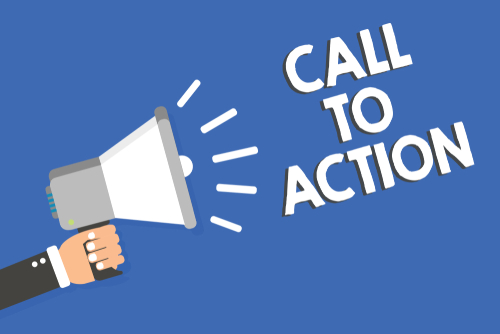 Reading Time: 3 minutes
Reading Time: 3 minutesWritten content is an incredibly powerful marketing asset – as long as you know how to maximize its effectiveness. One of the most crucial components of any effective piece of written content is the call to action (CTA), or the portion of a piece of written content that compels a reader to take the next step on their journey with your brand. CTAs should have places within every channel of your published content, including your marketing emails, press releases, social media posts, and blogs published to your site.
A CTA may seem like a straightforward concept at first, but there is quite a bit of psychology behind a good CTA. It’s vital to create CTAs that compel the appropriate reaction without sounding pushy, convey authority without sounding condescending, and convey value without being overbearing. A good CTA should drive the behavior you want to see from the people reading your content in a positive way. The following tips will help you maximize the effectiveness of your CTAs and increase the return on investment of the content you produce.
Step One: Understand the Role of the CTA
A well-constructed CTA should accomplish three specific goals:
- Motivate your sales funnel.
- Offer customers what they want.
- Increase the effectiveness of your digital advertising.
Creating better CTAs requires a firm understanding of the purpose behind CTAs. A good CTA should serve as the transition between two phases of a buyer’s journey with your brand. CTAs instruct readers and customers what to do next, how to get the most value out of your brand, and convey tangible value.
Believe it or not, many customers want CTAs and expect them without realizing it. They want to know what to do next once they begin engaging with your brand. After consuming a piece of content, the average customer will expect you to request an action, and the CTA should act as a guide to the next phase of the customer’s relationship with you.
Step Two: Be Direct
Your CTA should stand apart from the rest of your content and offer clear directions to the reader. Ideally, your CTA should take the form of a button linking to the next step in the buyer’s journey or at least stand out from the rest of the content in an obvious but unobtrusive way. Contextualize your CTA buttons to add value to the overall content piece and make sure your customers know what you want them to do next.
The directness of your CTA’s wording is up to you, but it’s important to make your expectations and directions clear. Consider the following examples of CTAs with varying levels of directness and urgency:
- “Contact us today for more information about our products and services.”
- “Sign up for our email list today to download a free eBook.”
- “If you have questions about this service, reach out to our team for more information.”
- “Click here to take advantage of this promotional offer.”
Depending on the type of product or service you’re attempting to draw your customers toward, you may want to experiment with different types of CTAs, include multiple options for taking the next step, and trying different visual design formats to see what works best for your content.
Step Three: Keep the CTA Cohesive but Prominent
Create some type of contrast between your CTA and the rest of the page without making the CTA stand too far apart from the rest of the content. Ideally, a CTA should be prominent without seeming detached from the rest of the content. For example, the CTA at the end of a written article or blog post should likely have its own heading and paragraph with an obvious link or button somewhere within the text.
Remember that some people who visit your site may grow so accustomed to seeing the same type of CTA on every page that they begin to automatically disregard them. Consider running some A/B testing to see which CTA formats work best so you can keep things interesting for your readers – and remember to change it up. No one wants to see the same tired line at the end of each post.
Step Four: Use Visual Guides for Readers
Humans like images and a break from text. Providing your readers with a bit of direction will go a long way toward guiding them down the intended journey path with your brand. A few options to consider for your CTAs might include:
- Experimenting with unconventional button shapes.
- Using high-contrast color schemes to draw the eye toward your CTAs.
- Implementing directional cues like arrows and splash effects to visually guide readers to your CTAs.
These techniques will help draw readers’ eyes where you want them to go, just be careful not to fall into the trap of overreliance on visual cues; focus on the text of your CTAs more than the graphics.
Step Five: Keep Testing to Find a Winning Formula
There is no one-size-fits-all solution to developing effective CTAs. You must create CTAs within the context of their individual pages for maximum effectiveness, and something that works for one piece of content may fall flat with another piece. A/B testing with different CTA styles and formats can help inform your content structure in the future. Keep experimenting and track the top-performing CTAs to find a strategy that works for you.




